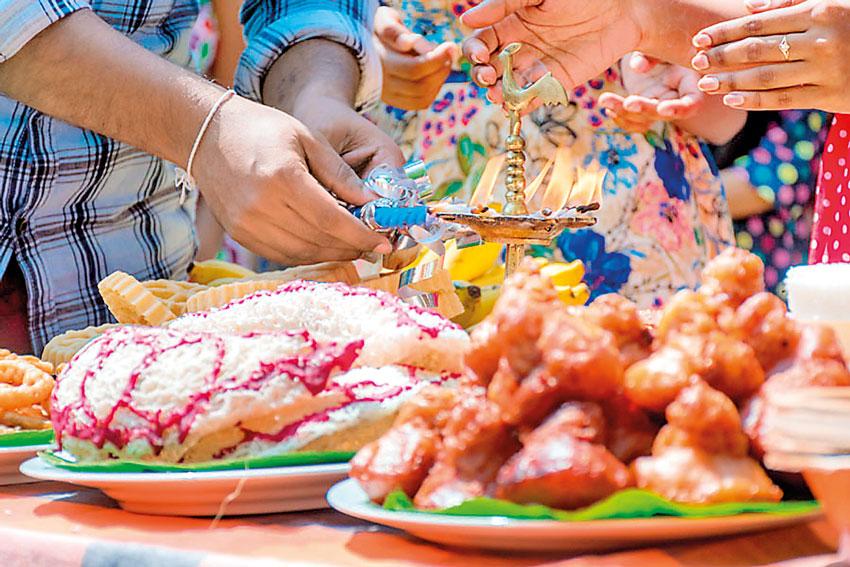Reply To:
Name - Reply Comment

 The most important cultural and national festival in our country falls in April. We in Sri Lanka, who believe in the solar influence on all living beings, observe this day as a day of religious and cultural significance.
The most important cultural and national festival in our country falls in April. We in Sri Lanka, who believe in the solar influence on all living beings, observe this day as a day of religious and cultural significance.

The month astrologically marks as a point in the circle in the sun-earth revolution. The sun is understood to traverse the twelve planets during the twelve months of the year. This change from the house of Meena (Pisces) to Mesha (Aries) is believed to be occurring on a day between April 12 and 15 in the Gregorian calendar.
Modern-day empirical scientists confirm the influence of the sun on living beings. Hindus in India come to the banks of rivers Ganges and Yamuna to observe the rising of the sun which they believe is auspicious to start the day. We in Sri Lanka observe this day as the Bak Maha Ulela. Bak, the month associated with luck (Bhagya)
It is during this month that the new harvest is collected from the paddy fields. Even nature adorns this month with trees, plants and creepers bearing plenty of fruits and blossomed flowers. The month of Bak is the most important month for the agricultural community.
This month is of special significance to Buddhists because it is on Bak full Poya Day that Gautama Buddha paid His second visit to Sri Lanka to settle a dispute between Naga kings, Chulodara and Mahodara.
The dawn of the Bak festival is heralded by the musical call of the bird koel. Due to the festivities Vesak and Poson celebrated during the following months, the festivities and religious activities continue till the end of Esala. After Bak comes Vesak and Poson, which are months of utmost importance to devout Buddhists, who participate in religious activities and pilgrimages.
These celebrations terminate in the Esala festivals devoted to gods and are celebrated throughout the country from the southernmost point of the island Dondra to the northernmost point, Paruthithurai. All the religious and cultural festivals bind the nation together and strengthen mutual friendship and understanding among the people.
Rituals
There are various rites and rituals associated with the national New Year festival. Most people renovate their houses, colour-wash and give a new look to their abodes.
The interim period between the sun’s transition from Pisces to Aries is known as the Sankranthi Kalaya and people refrain from working and engaging in religious activities during this period.
They are attired in new clothes in keeping with the prescribed colours for the year ahead.
People wait for the first meal of the New Year at the auspicious time and refrain from meals during the Nonagetha- the interim period between the old year and the New Year.
At the auspicious hour they light the hearth and prepare milk rice with the newly harvested paddy, mixed with ghee, and jaggery. Consuming this milk rice is also done at an auspicious time.
The head of the family will turn towards the direction prescribed by the astrologer, eat the first mouthful and feed the mother of the family followed by the children. This ritual is followed by other rites such as Ganu-denu which means the exchange of money, anointing medicinal oil standing on the prescribed medicinal leaves and starting the work at the auspicious hour.
Rites and rituals followed during the Sinhala and the Tamil New Year season strongly bind families together and strengthen the unity and understanding not only among the members of the family but also among other members of the society and the neighbourhood.
Offering a sheaf of betel to the elders and getting their blessings is a common practice observed on New Year’s Day.
Planting of tree apling is also one of the important rituals of the New Year.
Ganudenu
Our first interaction for the New Year is with the drinking water well. A coin washed with saffron and some medicinal herbs and seeds and tied to a bucket is dropped into the drinking water well and water is drawn to a new pot or bottle. This pot of water is kept intact until the following New Year’s Day occurring after a period of one year.
We expect the water in the pot to remain the same throughout the year for the New Year to be prosperous. Keeping a pot of water preserved for one year is a token. They preserved water in numerous ways.
Another tradition observed by them is to refrain from using fire during the Nonagetha period awaiting the arrival of the auspicious time to light the hearth.
Religious activities
In Sri Lanka, the harvest season coincides with the National New Year. It is a tradition among farmers to make offerings of milk rice prepared from the new crop to the temples. Often farmers combine these offerings with the offerings made on the occasion of the National New Year. Most Buddhists go to the temple on New Year’s Day as well as on Old Year Day Nonagetha period is devoted exclusively to religious activities.goodwill & bonding
During New Year’s Day friends and well-wishers exchange social visits carrying with them New Year gifts and presents. Visitors are treated with food and drink. Neighbours share milk rice and other eats prepared for New Year celebrations. Sports festivals organized in villages help people to cultivate qualities of co-existence, mutual assistance and reciprocity. The idea is to promote togetherness and mutual understanding among the participants.
Games such as Hiding the Comb (Mevara keliya), killing the Goat (Eluvan Mareema), and Raban Gaseema are played during the National New Year season. Some of these games are devoted to various Gods. We see that the Sinhala and Tamil New Year is the most important national festival in Sri Lanka that binds the people together promoting goodwill and understanding.
It is a body comprising companies such as Amazon, Apple, Booking.com, Expedia Group, Google, GoTo, Grab, LINE, LinkedIn, Meta, Rakuten, X and Yahoo.


